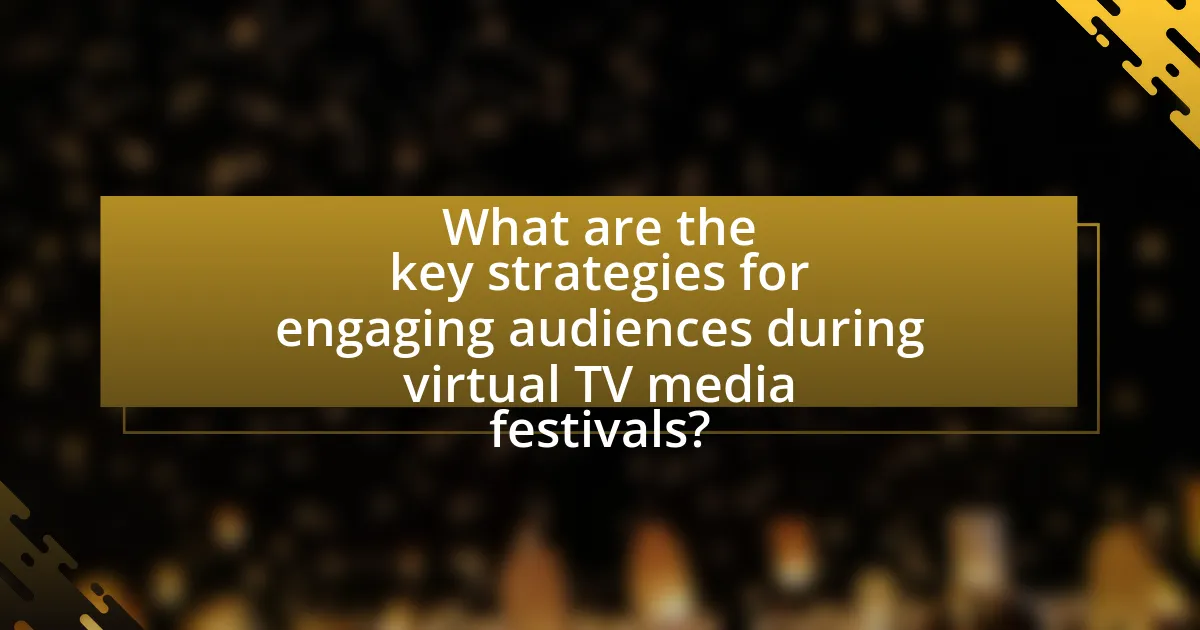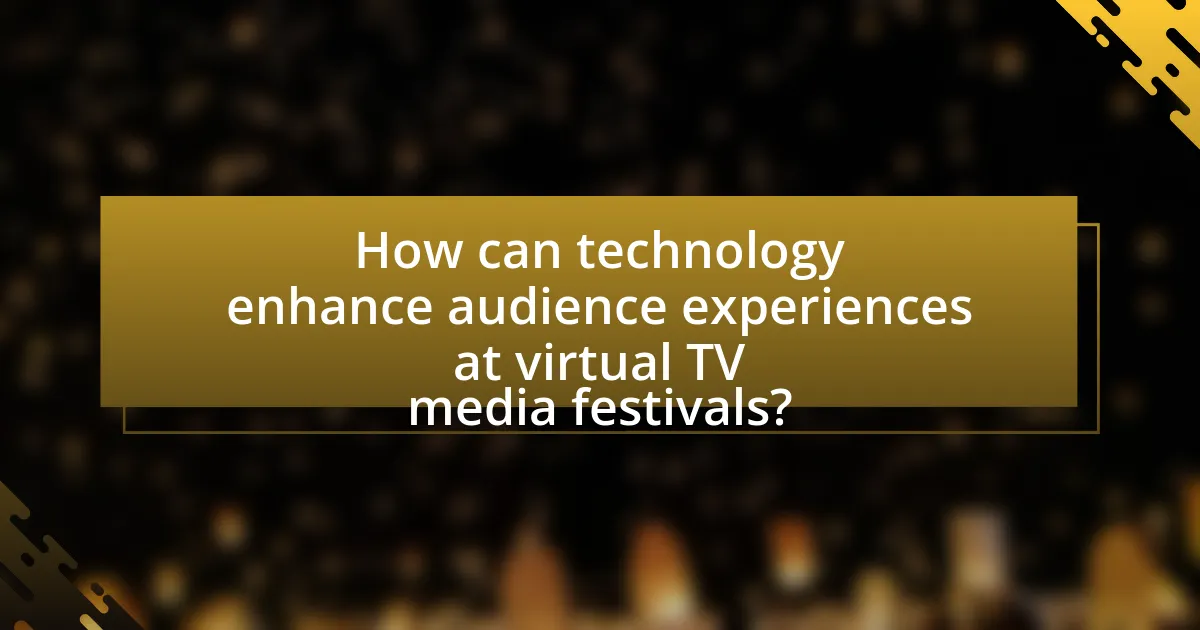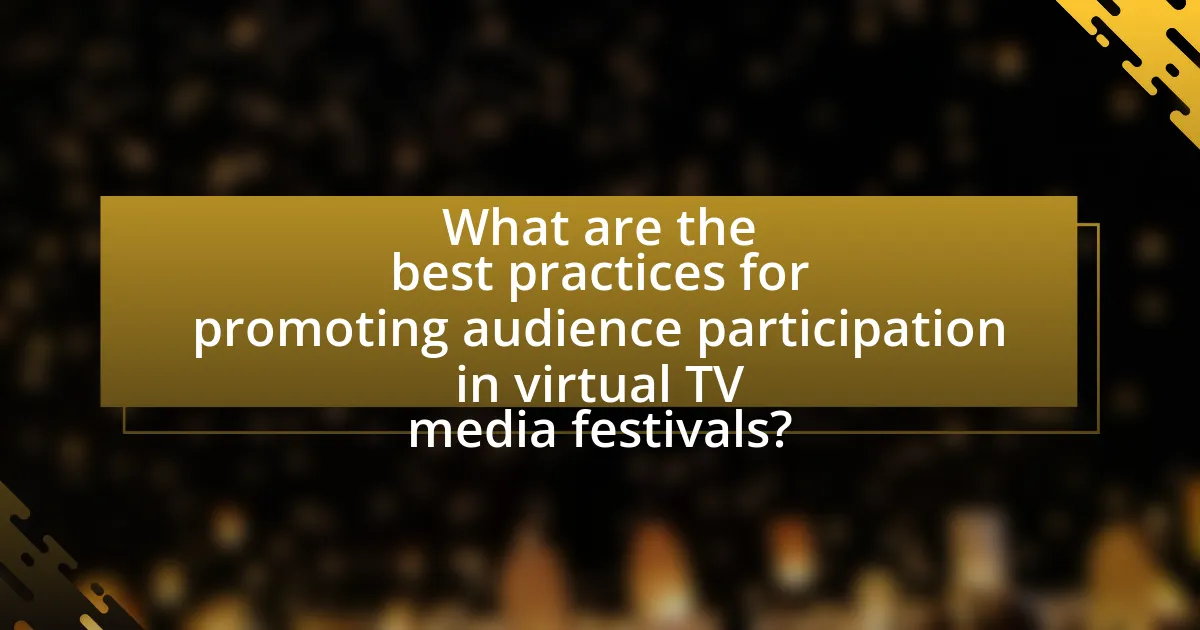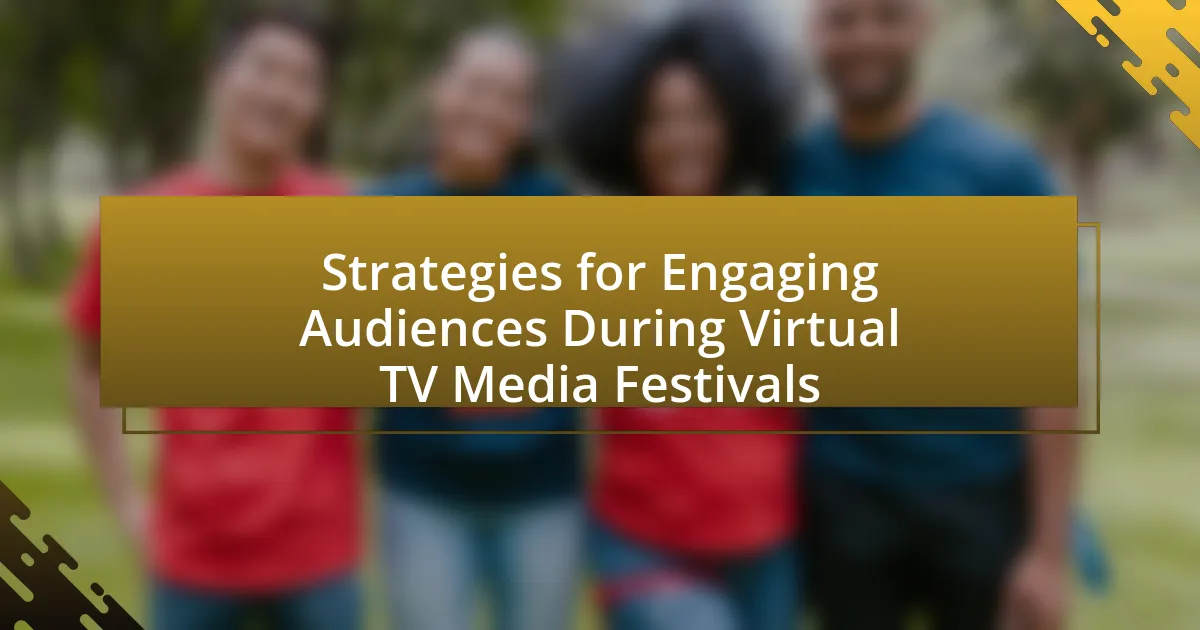The article focuses on strategies for engaging audiences during virtual TV media festivals, emphasizing the importance of interactive content, real-time participation, and personalized experiences. Key strategies include implementing live polls, Q&A sessions, and social media integration to foster community and enhance viewer retention. The article also discusses the significance of content variety, the role of technology such as virtual reality, and the impact of data analytics on audience engagement. Additionally, it outlines best practices for promoting participation and maintaining engagement post-event through effective follow-up strategies and audience feedback mechanisms.

What are the key strategies for engaging audiences during virtual TV media festivals?
Key strategies for engaging audiences during virtual TV media festivals include interactive content, real-time audience participation, and personalized experiences. Interactive content, such as polls and Q&A sessions, encourages viewers to actively participate, enhancing their connection to the event. Real-time audience participation through live chats or social media integration fosters a sense of community and immediacy, making viewers feel involved. Personalized experiences, such as tailored recommendations based on viewer preferences, increase relevance and engagement. These strategies are supported by studies showing that interactive and personalized content significantly boosts viewer retention and satisfaction during virtual events.
How can interactive elements enhance audience engagement?
Interactive elements enhance audience engagement by fostering active participation and creating a two-way communication channel. When audiences can interact through polls, Q&A sessions, or live chats, they feel more involved and invested in the content being presented. Research indicates that interactive formats can increase viewer retention rates by up to 70%, as participants are more likely to stay engaged when they can contribute their thoughts and feedback in real-time. This active involvement not only enhances the overall experience but also encourages a sense of community among viewers, making them more likely to return for future events.
What types of interactive features can be implemented?
Interactive features that can be implemented during virtual TV media festivals include live polls, Q&A sessions, chat functionalities, and interactive video content. Live polls allow audiences to express their opinions in real-time, enhancing engagement and providing immediate feedback. Q&A sessions enable viewers to interact directly with speakers or panelists, fostering a sense of connection. Chat functionalities facilitate ongoing discussions among participants, creating a community atmosphere. Interactive video content, such as clickable elements or branching narratives, allows viewers to choose their own paths, increasing immersion and participation. These features have been shown to significantly enhance viewer engagement and satisfaction in virtual events.
How do interactive elements influence viewer participation?
Interactive elements significantly enhance viewer participation by fostering engagement and creating a sense of involvement. When viewers can interact through polls, Q&A sessions, or live chats, they feel more connected to the content and the creators, leading to increased attention and retention. Research indicates that interactive features can boost audience engagement by up to 70%, as they encourage active participation rather than passive consumption. This heightened involvement not only enhances the viewer experience but also provides valuable feedback for creators, allowing them to tailor content to audience preferences.
Why is content variety important for audience retention?
Content variety is crucial for audience retention because it keeps viewers engaged and prevents boredom. When audiences encounter diverse content types, such as videos, articles, and interactive elements, they are more likely to remain interested and return for more. Research indicates that platforms offering varied content see higher engagement rates; for instance, a study by HubSpot found that 60% of consumers prefer to see a mix of content formats. This variety caters to different preferences and learning styles, enhancing the overall viewing experience and fostering loyalty among audiences.
What types of content resonate most with virtual audiences?
Interactive content, such as polls, quizzes, and live Q&A sessions, resonates most with virtual audiences. This type of content fosters engagement by encouraging participation and creating a sense of community among viewers. According to a study by HubSpot, interactive content generates twice the engagement of static content, highlighting its effectiveness in capturing audience attention. Additionally, video content, particularly short-form videos, has been shown to increase viewer retention and sharing rates, making it another highly effective format for virtual audiences.
How can diverse programming attract different audience segments?
Diverse programming can attract different audience segments by offering a variety of content that resonates with the unique interests and cultural backgrounds of those segments. This approach allows media festivals to cater to a broader demographic, enhancing viewer engagement and satisfaction. For instance, research by the Pew Research Center indicates that diverse representation in media leads to increased viewership among underrepresented groups, as they see their experiences reflected in the programming. By including genres, themes, and narratives that appeal to various cultural, social, and age demographics, festivals can effectively draw in a wider audience, fostering inclusivity and community engagement.
What role does social media play in audience engagement?
Social media serves as a crucial platform for audience engagement by facilitating real-time interaction and feedback between creators and viewers. This dynamic allows audiences to participate actively in discussions, share content, and express their opinions, which enhances their connection to the media being presented. According to a study by the Pew Research Center, 69% of adults in the U.S. use social media, indicating its widespread influence and potential for engaging large audiences. Furthermore, social media platforms enable targeted marketing and personalized content delivery, which can significantly increase viewer participation and loyalty during events like virtual TV media festivals.
How can social media be effectively integrated into virtual festivals?
Social media can be effectively integrated into virtual festivals by creating interactive experiences that encourage audience participation and real-time engagement. Utilizing platforms like Twitter, Instagram, and Facebook allows organizers to share live updates, behind-the-scenes content, and facilitate discussions through hashtags, which can enhance community building. For instance, a study by the Pew Research Center found that 69% of adults in the U.S. use social media, indicating a broad audience reach that can be leveraged for promoting events and engaging viewers. Additionally, incorporating user-generated content, such as live polls and Q&A sessions, can further enhance audience involvement and create a sense of belonging, making the virtual festival experience more immersive and enjoyable.
What strategies can be used to encourage social sharing during events?
To encourage social sharing during events, implement interactive elements such as live polls, Q&A sessions, and social media contests. These strategies actively engage attendees, prompting them to share their experiences online. For instance, a study by Eventbrite found that events incorporating interactive features saw a 30% increase in social media mentions compared to traditional formats. Additionally, providing shareable content, such as branded hashtags and visually appealing graphics, facilitates easy sharing on platforms like Twitter and Instagram. By creating a sense of community and excitement, these strategies effectively enhance social sharing during events.

How can technology enhance audience experiences at virtual TV media festivals?
Technology can enhance audience experiences at virtual TV media festivals by providing interactive features, real-time engagement tools, and immersive content delivery. Interactive features such as live polls, Q&A sessions, and chat functionalities allow audiences to participate actively, fostering a sense of community and involvement. Real-time engagement tools, including social media integration and live streaming, enable viewers to share their experiences and connect with others instantly, increasing overall engagement. Immersive content delivery through virtual reality (VR) and augmented reality (AR) can create unique viewing experiences, allowing audiences to explore content in innovative ways. For instance, a study by the Interactive Advertising Bureau found that 70% of users reported a more engaging experience when using interactive content compared to passive viewing. These technological advancements collectively enhance the overall experience, making virtual TV media festivals more dynamic and appealing to audiences.
What technological tools are essential for virtual festivals?
Essential technological tools for virtual festivals include live streaming platforms, interactive event software, and social media integration. Live streaming platforms, such as Zoom or YouTube Live, enable real-time broadcasting of performances and discussions, allowing audiences to participate from anywhere. Interactive event software, like Hopin or Whova, facilitates networking, scheduling, and engagement through features such as chat rooms and Q&A sessions. Social media integration enhances audience interaction and promotion, leveraging platforms like Facebook and Twitter to create buzz and community engagement around the festival. These tools collectively enhance the virtual experience, ensuring audience participation and satisfaction.
How do streaming platforms impact audience engagement?
Streaming platforms significantly enhance audience engagement by providing on-demand access to content, which allows viewers to watch at their convenience. This flexibility leads to increased viewer retention and interaction, as audiences can choose what to watch and when, resulting in higher satisfaction levels. According to a report by Nielsen, streaming services have seen a 60% increase in viewership during peak hours, indicating that audiences are more engaged when they have control over their viewing experience. Additionally, features such as live chats, social media integration, and personalized recommendations further foster community interaction and keep viewers invested in the content.
What role does virtual reality play in enhancing viewer experiences?
Virtual reality significantly enhances viewer experiences by immersing audiences in interactive environments that engage multiple senses. This immersive quality allows viewers to feel as though they are part of the action, leading to increased emotional connection and engagement with the content. Research indicates that virtual reality can increase viewer retention rates by up to 70% compared to traditional media formats, as users are more likely to remember experiences that involve active participation. Additionally, studies show that 85% of users report feeling a stronger emotional response when experiencing content in virtual reality, further validating its role in enhancing viewer experiences.
How can data analytics improve audience engagement strategies?
Data analytics can significantly enhance audience engagement strategies by providing insights into viewer behavior and preferences. By analyzing data such as viewing patterns, demographic information, and interaction rates, organizations can tailor content and marketing efforts to better meet the needs of their audience. For instance, a study by Nielsen found that targeted content based on viewer analytics can increase engagement rates by up to 30%. This data-driven approach allows for the optimization of programming schedules and promotional tactics, ensuring that content resonates with the audience, ultimately leading to higher retention and satisfaction levels.
What metrics should be tracked to assess audience engagement?
To assess audience engagement, key metrics include viewer retention rate, interaction rate, social media shares, and comments. Viewer retention rate measures how long audiences stay engaged with content, indicating its relevance and appeal. Interaction rate, which encompasses likes, shares, and comments, reflects the level of audience participation and interest. Social media shares demonstrate the content’s reach and influence, while comments provide qualitative insights into audience sentiment and feedback. Tracking these metrics allows for a comprehensive understanding of audience engagement during virtual TV media festivals.
How can audience feedback be utilized to refine future events?
Audience feedback can be utilized to refine future events by systematically collecting and analyzing participant responses to identify strengths and weaknesses in event execution. This process allows organizers to understand audience preferences, improve content relevance, and enhance overall engagement. For instance, surveys conducted post-event can reveal specific areas where attendees felt satisfied or dissatisfied, enabling targeted adjustments for future programming. Research indicates that events that actively incorporate audience feedback see a 20% increase in participant satisfaction ratings, demonstrating the effectiveness of this approach in fostering a more engaging experience.

What are the best practices for promoting audience participation in virtual TV media festivals?
To promote audience participation in virtual TV media festivals, organizers should implement interactive elements such as live polls, Q&A sessions, and social media engagement. These practices encourage real-time interaction, making the audience feel involved and valued. For instance, incorporating live polls during screenings can yield immediate feedback and foster a sense of community among viewers. Additionally, utilizing platforms like Twitter or Instagram for audience discussions can enhance engagement, as studies show that social media interaction increases viewer retention and satisfaction. By creating opportunities for audience input and dialogue, festivals can significantly boost participation and enhance the overall experience.
How can pre-event marketing drive audience interest?
Pre-event marketing can drive audience interest by creating anticipation and excitement around the event. Effective strategies include targeted social media campaigns, email marketing, and engaging content that highlights key speakers, topics, and unique experiences attendees can expect. For instance, a study by Eventbrite found that 80% of event attendees are influenced by social media promotions, indicating that well-executed pre-event marketing can significantly boost audience engagement and attendance.
What channels are most effective for promoting virtual festivals?
Social media platforms are the most effective channels for promoting virtual festivals. These platforms, including Facebook, Instagram, and Twitter, enable direct engagement with target audiences through interactive content, live updates, and targeted advertising. According to a study by Eventbrite, 80% of event organizers reported that social media was their most effective marketing tool, highlighting its role in reaching a wider audience and fostering community engagement. Additionally, email marketing remains a powerful channel, with a return on investment of $42 for every dollar spent, as reported by the Data and Marketing Association. This combination of social media and email marketing creates a robust strategy for maximizing visibility and participation in virtual festivals.
How can partnerships enhance promotional efforts?
Partnerships can enhance promotional efforts by leveraging combined resources and audiences to increase visibility and engagement. When two or more organizations collaborate, they can pool their marketing budgets, share expertise, and access each other’s customer bases, resulting in a broader reach. For instance, a study by the Harvard Business Review found that companies engaging in strategic partnerships can experience up to a 30% increase in brand awareness. This collaborative approach not only amplifies promotional messages but also fosters credibility, as audiences often trust recommendations from familiar brands.
What post-event strategies can maintain audience engagement?
Post-event strategies that can maintain audience engagement include follow-up communication, content sharing, and community building. Follow-up communication, such as personalized thank-you emails or surveys, reinforces the connection with attendees and gathers valuable feedback for future events. Content sharing, including recorded sessions, highlights, and behind-the-scenes footage, keeps the event alive in the audience’s mind and encourages ongoing interaction. Community building through social media groups or forums fosters a sense of belonging and allows attendees to continue discussions and share experiences. These strategies are supported by research indicating that sustained engagement post-event can lead to increased loyalty and participation in future events.
How can follow-up content keep the audience connected?
Follow-up content keeps the audience connected by providing ongoing engagement and reinforcing the initial message. This type of content can include updates, additional insights, or interactive elements that encourage audience participation. For instance, a study by the Content Marketing Institute found that 70% of consumers prefer to learn about a company through articles rather than ads, indicating that follow-up content can enhance audience loyalty and interest. By consistently delivering relevant information, brands can maintain a relationship with their audience, fostering a sense of community and ongoing dialogue.
What are effective ways to gather and implement audience feedback?
Effective ways to gather and implement audience feedback include utilizing surveys, social media interactions, and live polls during events. Surveys can be distributed post-event to collect structured feedback, while social media platforms allow for real-time engagement and informal feedback. Live polls during virtual sessions enable immediate audience input, fostering a sense of participation. According to a study by the Pew Research Center, 72% of adults use social media, making it a valuable tool for gathering insights. Implementing this feedback involves analyzing the data collected to identify trends and areas for improvement, ensuring that audience preferences are integrated into future programming.
What practical tips can enhance audience engagement during virtual TV media festivals?
To enhance audience engagement during virtual TV media festivals, organizers should implement interactive elements such as live polls, Q&A sessions, and chat features. These tools allow viewers to participate actively, fostering a sense of community and involvement. Research indicates that events incorporating interactive features see a 30% increase in audience retention compared to those that do not. Additionally, utilizing social media platforms for real-time updates and discussions can further engage the audience, as 70% of participants report feeling more connected when they can share their thoughts online during events.

Leave a Reply